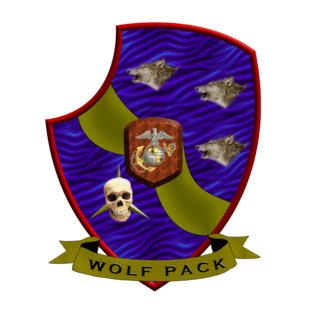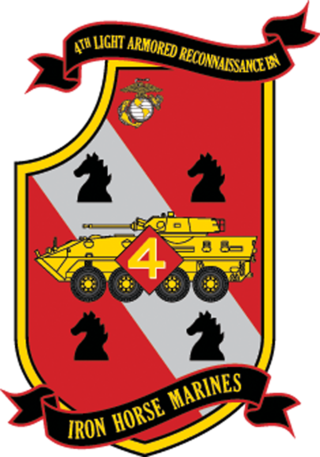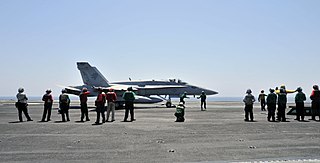
The First Battle of Fallujah, code-named Operation Vigilant Resolve, was an operation against militants in Fallujah as well as an attempt to apprehend or kill the perpetrators of the killing of four U.S. contractors in March 2004.

The Second Battle of Fallujah, initially codenamed Operation Phantom Fury,Operation al-Fajr was an American-led offensive of the Iraq War that lasted roughly six weeks, starting 7 November 2004. Marking the highest point of the conflict against the Iraqi insurgency, it was a joint military effort carried out by the United States, the Iraqi Interim Government, and the United Kingdom. Within the city of Fallujah, the coalition was led by the U.S. Marine Corps and U.S. Army, the battle was later described as "some of the heaviest urban combat U.S. military have been involved in since the Battle of Huế City in Vietnam in 1968".

The Battle of Khafji was the first major ground engagement of the Gulf War. It took place in and around the Saudi Arabian city of Khafji, from 29 January to 1 February 1991.

Ar-Rutbah is an Iraqi town in western Al Anbar province, completely inhabited with Sunni Muslims. The population is approximately 28,400. It occupies a strategic location on the Amman–Baghdad road, and the Kirkuk–Haifa oil pipeline. Considered a "wet spot", it receives 114.3 mm (4.5 inches) of rain annually, and is located on a high plateau. It has been described as "the most isolated town of any size in Iraq."

Operation Steel Curtain was a military operation executed by coalition forces in early November 2005 to reduce the flow of foreign insurgents crossing the border and joining the Iraqi insurgency. The operation was important in that it was the first large scale deployment of the New Iraqi Army. This offensive was part of the larger Operation Sayeed (Hunter), designed to prevent al Qaeda in Iraq from operating in the Euphrates River Valley and throughout Al Anbar and to establish a permanent Iraqi Army presence in the Al Qa’im region.

1st Light Armored Reconnaissance Battalion is a fast and mobilized armored terrestrial reconnaissance battalion of the United States Marine Corps. Nicknamed the "Highlanders," their primary weapon system is the LAV-25 Light Armored Vehicle armed with the M242 25mm Bushmaster chain gun. They fall under the command of the 1st Marine Division and the I Marine Expeditionary Force. The unit is based out of the Marine Corps Base Camp Pendleton, California.

2nd Light Armored Reconnaissance Battalion is a fast and mobilized armored terrestrial reconnaissance battalion of the United States Marine Corps. Their primary weapon system is the 8-wheeled LAV-25 and they fall under the command of the 2nd Marine Division and II Marine Expeditionary Force. The unit is based out of the Marine Corps Base Camp Lejeune, North Carolina. The current mission statement of the battalion is: To perform combined arms reconnaissance and security missions in support of the Ground Combat Element (GCE) of a Marine Air-Ground Task Force (MAGTF). Its mission is to conduct reconnaissance, security and economy of force operations, and, within its capabilities, limited offensive or defensive operations that exploit the unit's mobility and firepower.

3d Light Armored Reconnaissance Battalion(3D LAR BN) is a fast and mobilized armored terrestrial reconnaissance battalion of the United States Marine Corps. Their primary weapon system is the LAV-25 and they are part of the 1st Marine Division and I Marine Expeditionary Force. The unit is based out of the Marine Corps Air Ground Combat Center Twentynine Palms, California.

The 3rd Battalion 7th Marine Regiment (3/7) is an infantry battalion of the United States Marine Corps. They are based at the Marine Corps Air Ground Combat Center Twentynine Palms and consist of approximately 800 Marines. The battalion falls under the command of the 7th Marine Regiment and the 1st Marine Division. The battalion has seen combat in World War II, the Korean War, the Vietnam War, the Gulf War and was a part of the main effort during the initial invasion of Iraq in 2003. During the Global War on Terror, the battalion saw eleven sequential combat deployments; five in support of Operation Iraqi Freedom, three in support of Operation Enduring Freedom, and three in support Operation Inherent Resolve. The unit has a long, decorated history with countless achievements. Its members were described as "true professionals" by embedded reporters during the 2003 invasion of Iraq.

3rd Battalion, 23rd Marine Regiment (3/23) is a reserve infantry battalion in the United States Marine Corps located throughout the Southern United States consisting of approximately 800 Marines and Sailors. The battalion was first formed in 1943 for service in the Central Pacific Area during World War II, taking part in a number of significant battles including those at Saipan and Iwo Jima before being deactivated at the end of the war. In the early 1960s, the unit was reactivated as a reserve battalion. The battalion is headquartered in Saint Louis, Missouri, with outlying units throughout the Southern United States. 3/23 falls under the command of the 23rd Marine Regiment and the 4th Marine Division. Recent operations have included tours in Iraq and Afghanistan.

4th Light Armored Reconnaissance Battalion is a United States Marine Corps Light Armored Reconnaissance battalion of the Marine Corps Reserve. Their primary weapon system is the LAV-25 and they are part of the 4th Marine Division and Marine Forces Reserve. The unit headquarters is at Camp Pendleton, California, but other units in the battalion are located throughout the United States. 4th LAR Bn is the largest combat battalion in the Marine Corps, with 7 companies.

The Battle of Al-Qa'im was a military offensive conducted by the United States Marine Corps, against insurgent positions in Iraq's northwestern Anbar province, which ran from 8 May 2005 to 19 May 2005. It was focused on eliminating insurgents and foreign fighters in a region known as a smuggling route and a sanctuary for foreign fighters.

The Battle of Ramadi was fought during the Iraq War from March 2006 to November 2006, for control of the capital of the Al Anbar Governorate in western Iraq. A joint US military force under the command 1st Brigade Combat Team, 1st Armored Division and Iraqi Security Forces fought insurgents for control of key locations in Ramadi. Coalition strategy relied on establishing a number of patrol bases called Combat Operation Posts throughout the city.

The Battle of Baqubah II took place during the Iraq War in the capital of the Iraqi province Diyala, to the north-east of Baghdad. It began in early March 2007, when U.S. and Iraqi forces commenced preliminary operations to "establish a presence in Diyala beyond their Forward Operating Base".
Operation Murfreesboro was one of the closing engagements of the Battle of Ramadi during the Iraq War and resulted in a decisive victory for the United States Forces over the Islamic State of Iraq. It is widely credited with breaking the back of the insurgency in Anbar Province, resulting in the Anbar province favoring the new Iraqi government in Baghdad.

Operation Strike of the Sword or Operation Khanjar was a US-led offensive in Helmand province in southern Afghanistan. About 4,000 Marines from the 2nd Marine Expeditionary Brigade as well as 650 Afghan troops were involved, supported by NATO planes. The operation began when units moved into the Helmand River valley in the early hours of July 2, 2009. This operation was the largest Marine offensive since the Battle of Fallujah in 2004. The operation was also the biggest offensive airlift by the Marines since the Vietnam War.

Operation Sayeed also known as Operation Hunter in English, was a series of operations conducted in western Al Anbar Governorate by the United States Marine Corps in 2005. It was an umbrella operation, consisting of at least 11 named operations between July 2005 to December 2005. The purpose was to drive Al-Qaeda in Iraq forces from the Western Euphrates River Valley. Some parts of Operation Sayeed were Operation Steel Curtain and Operation Iron Fist.
Sahl Sinjar Air Base is a former Iraqi Air Force base in the Nineveh Governorate of Iraq. It was captured by Coalition forces during Operation Iraqi Freedom in 2003.

On 15 June 2014, U.S. President Barack Obama ordered United States forces to be dispatched in response to the Northern Iraq offensive of the Islamic State (IS) as part of Operation Inherent Resolve. At the invitation of the Iraqi government, American troops went to assess Iraqi forces and the threat posed by ISIL.
The 2017 Western Nineveh offensive, code-named Operation Muhammad, Prophet of God, was launched by the Iraqi Popular Mobilization Forces (PMF) against the Islamic State of Iraq and the Levant (ISIL) in the western Nineveh province of northern Iraq in late April 2017.














